Fact Sheet FS1347
Large crabgrass (Digitaria sanguinalis) is an annual weed found across New Jersey. It is commonly found on roadsides, fallow land, and in farm production areas. Large crabgrass can form robust root systems thanks to its numerous tillers and capacity to root at nodes, allowing it to out-compete crops for moisture and nutrients. Understanding the life cycle and biology of large crabgrass is key to figuring out the best options for its control on your farm.
Plant Description and Growth Habit
Large crabgrass reproduces through seeds. These seeds can survive in the soil for up to three years, depending on their depth from the soil surface. Plants emerge from the soil in late spring and early summer, once the soil temperature exceeds 50–58°F. In New Jersey, seedling emergence currently starts in late April and peaks in May before rapidly declining during the summer. Roots form at the nodes found on tillers of established plants, allowing for multiple plants to be formed from one plant when these rooted nodes are separated from the main plant. Flowers will set seed when the length of the day begins to shorten through the first hard frost. Plant density impacts seed production, which can range between 100 to 145,000 seeds produced per plant. Large crabgrass is frost-sensitive, grows best at high temperatures, and can withstand drought conditions. Roots can penetrate up to 6' deep in loam soils. Large crabgrass tends to be more prevalent and therefore a bigger issue in perennial cropping systems, such as tree fruit and blueberries, and in no-till fields when compared to annual cropping systems where there is regular cultivation. Large crabgrass tolerates a wide range of soil conditions, but grows especially well in well-drained soils, and responds positively to improved soil fertility. Characteristics of large crabgrass include:
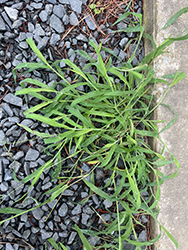
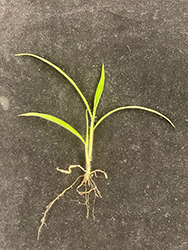
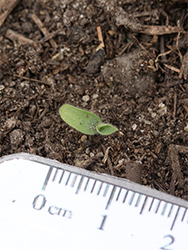
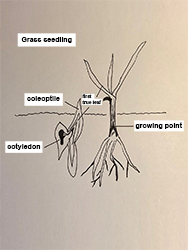
Management Strategies
Control of large crabgrass at the seedling stage (≤ 2–3" tall) is much easier to do before more extensive roots and tillers develop. Seedlings are easily killed by using weeders or rotary hoeing just after they emerge but before they start tillering. Weeding of larger plants should be done in a manner that exposes the entire root system at the surface, allowing it to dry and die, as partially buried plants can re-root and continue to grow. Organic and no-spray farming operations can utilize well-timed weeding and cultivation to kill newly emerged plants. Early detection and multiple control methods are needed to reduce the presence of large crabgrass throughout the farm.
Flame or steam weeders can be effective at controlling young crabgrass seedlings but will loose efficacy as crabgrass is tillering and growing taller. Because the growing point of crabgrass is located at or below the ground surface and protected by layers of leaves, the plant can easily generate new leaves after being exposed to heat.
Prevention
Weeding, Mowing, and Cultivation
Competition, Stale Seedbed, and Mulching
Farm Decision Tool
Large crabgrass management is a multi-year process for farms not relying on synthetic herbicides. Identification and mapping of existing populations on the farm, along with reflection on your activities and how they impact these populations, is the first step to developing a management plan.
Use the charts below to identify your large crabgrass populations, your current management methods, and develop a plan of action to reduce large crabgrass from your production areas.
| Crabgrass Field Locations | |||
|---|---|---|---|
| Field | Size of Population | Suspected Introduction | Future Prevention Plan |
| Example: Field 4 | Patchy throughout | Equipment borrowed | |
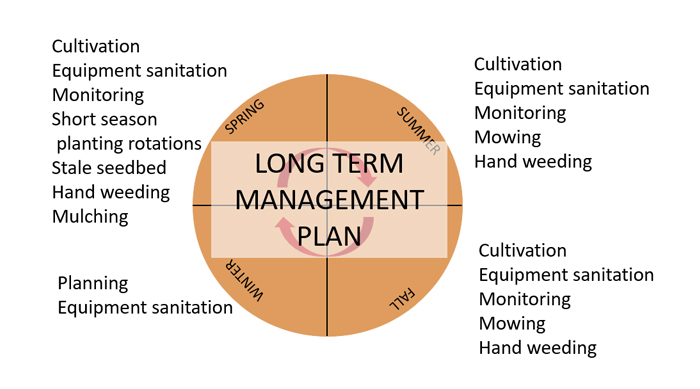
Figure 5. Long-term management plan.
| Current Strategies | Timeframe |
|---|---|
| Example: hand weeding | spring |
| Potential Future Strategies | Timeframe |
|---|---|
| Weed on 21-day cycle, mow monthly | spring–fall |
References
- Grubinger, V. (2004). Flaming Stale Seedbeds for Weed Control.
- Lounsbury, N., Birthisel, S., Lilley, J., Maher, R. (2022). Tarping in the Northeast: A Guide for Small Farms (PDF). University of Maine.
- Mohler, C., Teasdale, J., DeTommaso, A. (2021). Manage Weeds on Your Farm: A Guide to Ecological Strategies. USDA Sustainable Agriculture.
- Mohler, C., Johnson, S. (2009). Crop Rotation on Organic Farms. USDA Sustainable Agriculture Research and Education.
- Northeast Cover Crops Council (2021). Cover Crop Decision Support Tools.
- Uva, R., Neal, J., DiTomasso, J. (1997). Weeds of the Northeast. Cornell University Press.
August 2022
Copyright © 2024 Rutgers, The State University of New Jersey. All rights reserved.
For more information: njaes.rutgers.edu.
Cooperating Agencies: Rutgers, The State University of New Jersey, U.S. Department of Agriculture, and Boards of County Commissioners. Rutgers Cooperative Extension, a unit of the Rutgers New Jersey Agricultural Experiment Station, is an equal opportunity program provider and employer.

